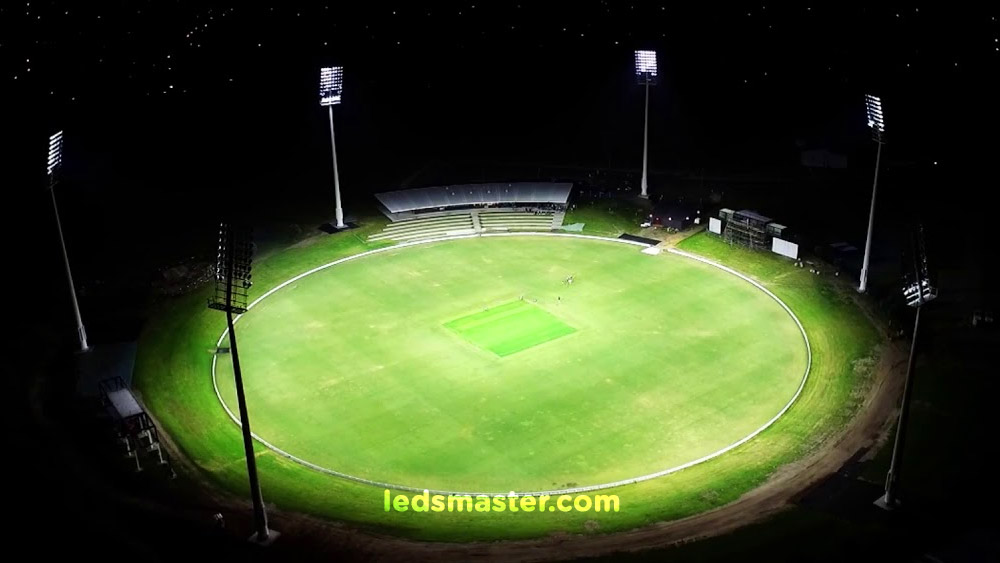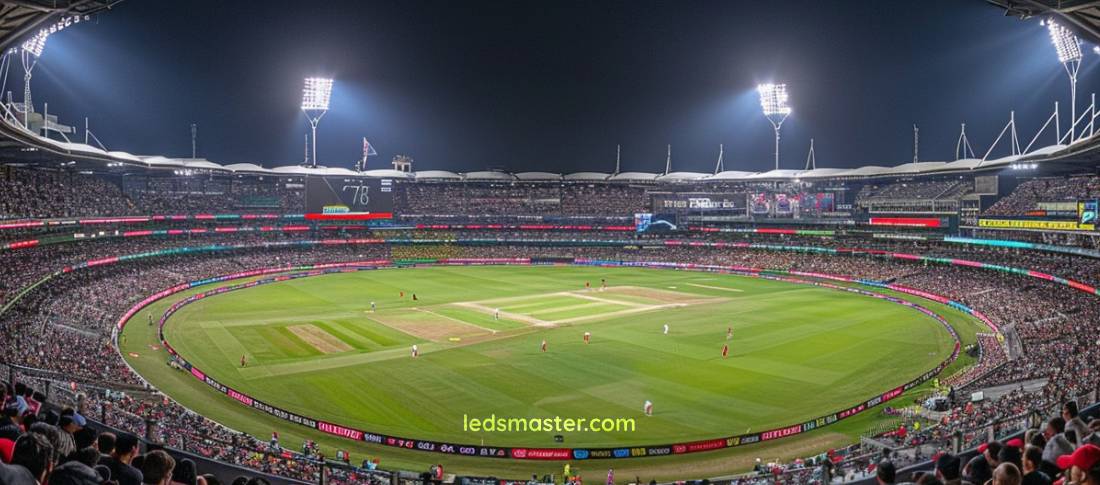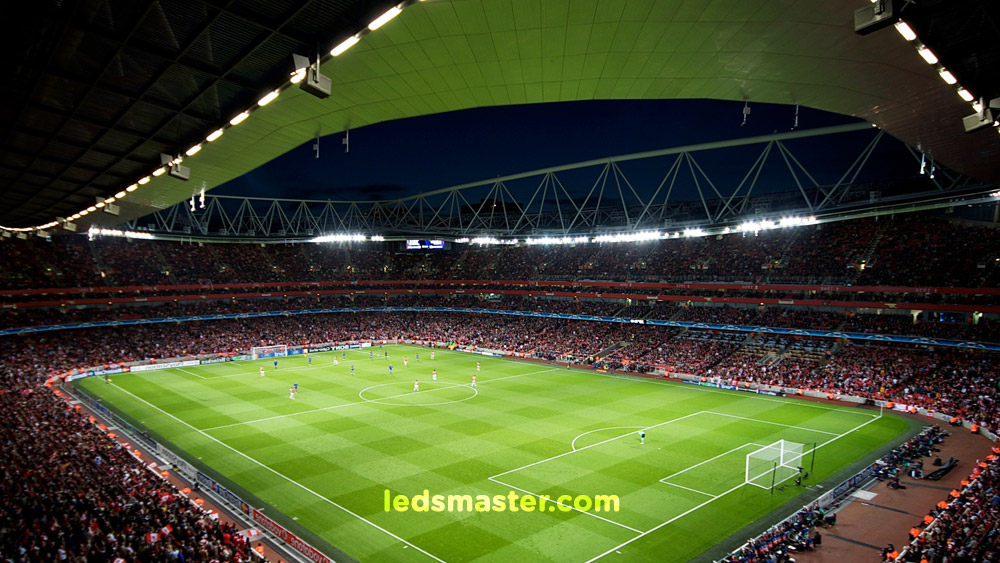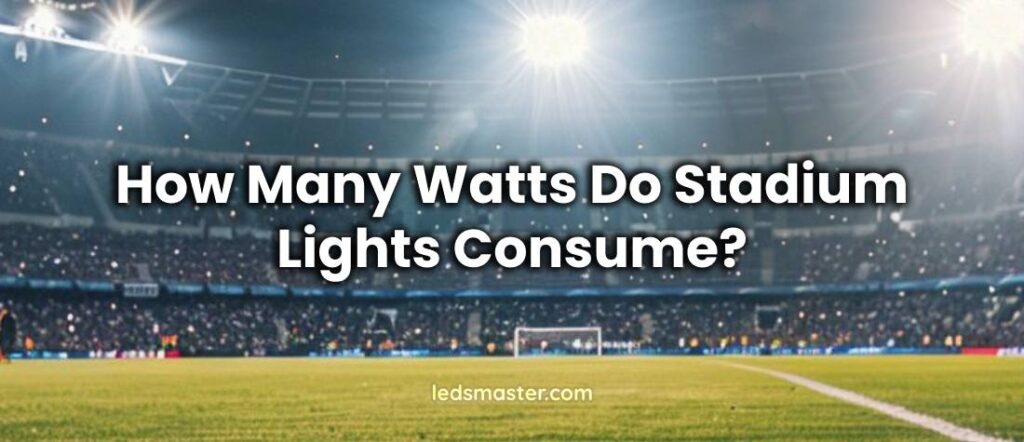Table of Contents
ToggleIntroduction
When designing lighting systems for stadiums—whether they host football, baseball, or cricket—accurately determining the wattage of the lights is essential for optimal placement on poles. Each stadium presents unique challenges and configurations, making it imperative to meticulously assess and meet its specific wattage requirements.
In recent years, there has been a significant trend among stadium operators towards upgrading from conventional metal halide or mercury vapor lamps to more energy-efficient LED alternatives. This transition is driven by the desire to reduce energy consumption and maintenance costs while improving lighting quality and consistency throughout the venue. Understanding the wattage of these older HID lamps is crucial during this shift, as it informs decisions regarding fixture replacement and overall lighting design.
Understanding Typical Wattages of Stadium Lighting
Based on our findings, stadium lights commonly range from 400W to 1500W, delivering between 64,000lm and 240,000lm per light. These wattages are popular because they offer sufficient brightness to illuminate entire stadiums effectively, balancing power with practical size considerations.
| Watts of stadium lights | Applications |
| 400 watts | Basketball stadium, tennis arena, baseball stadium |
| 500 watts | Baseball stadium, soccer stadium |
| 750 watts | High school football stadium, cricket stadium |
| 1000 watts | General stadiums (It can be used in almost all types of stadiums and arenas) |
| 1500 watts | Stadiums for Olympic Games, Premier League, ICC etc. |
Based on the table provided, 400W and 500W floodlights are primarily utilized in smaller stadiums like those for basketball and tennis. This choice mitigates the risk of creating blind spots and ensures uniform and high-quality lighting.
In contrast, larger stadiums such as those for football, soccer, and cricket typically employ LED stadium lights ranging from 1000W to 1500W. Using lower wattage lights in these venues would require a higher quantity of fixtures to adequately illuminate the space, potentially increasing installation costs significantly. Thus, opting for higher wattage stadium lighting is more suitable and cost-effective for these expansive sports arenas.
What Wattage are Cricket Stadium Lights?

Cricket stadium lighting wattage is categorized into three classes: Class I, Class II, and Class III. Class I pitches, designed for international matches such as those sanctioned by the ICC, typically require between 80,000 and 250,000 watts of LED lighting. In contrast, using HID lights would necessitate a much higher wattage of around 2,750,000 watts to adequately illuminate the cricket field. Refer to the table below for a detailed breakdown of wattage requirements for various types of light sources.
Class I Cricket Stadium Lights Watts
| Type of lighting | Wattage needed for class I cricket stadium |
| LED lights | 80,000 to 250,000 watts |
| Metal halide lights | 250,000 to 750,000 watts |
| Mercury vapor lights | 500,000 to 150,000 watts |
| Halogen lights | 1,000,000 to 2,750,000 watts |
Professional cricket stadiums face substantial electricity costs when using halogen lamps due to their high wattage demands. LED lamps offer a significant advantage over halogen counterparts, boasting approximately ten times higher luminous efficacy. This efficiency means LEDs can provide equivalent illumination using only a fraction of the power required by halogen lamps. Transitioning from HID lamps to LEDs not only reduces energy consumption but also results in considerable operational cost savings for stadium owners and operators. This shift aligns with global trends toward sustainability and energy efficiency in sports facility management, making LED technology a preferred choice for modernizing stadium lighting infrastructure.
In addition to horizontal lighting requirements, cricket field owners often need to address vertical illumination needs. Vertical lighting ensures uniform brightness across the playing surface and facilitates optimal viewing conditions for players and spectators. Meeting these specific lighting standards may require an additional 15 to 25% increase in wattage for LED installations. This adjustment ensures that the stadium lighting system delivers comprehensive coverage, enhancing the overall experience and safety during matches and events. By integrating advanced LED technologies and addressing both horizontal and vertical lighting needs, cricket stadiums can achieve optimal performance while minimizing environmental impact and operational costs.
Class II Cricket Stadium Lights Watts

Class II designation indicates the cricket field is hosting local matches or practices. As these events require less illumination compared to Class I international standards, LED cricket lights typically range from 45,000 to 110,000 watts
| Type of lighting | Watts of class II cricket stadium |
| LED lights | 45,000 to 110,000 watts |
| Metal halide lights | 120,000 to 370,000 watts |
| Mercury vapor lights | 240,000 to 700,000 watts |
| Halogen lights | 500,000 to 1,200,000 watts |
Even with conventional light sources, cricket fields still require millions of watts. Therefore, in terms of energy efficiency, LEDs consistently prove to be the superior choice. Although the initial cost of LEDs may be higher compared to HID lights, investing in LED lighting for cricket fields is ultimately worthwhile due to its efficiency and long-term savings.
Class III Cricket Stadium Lights Watts
Class III cricket fields are designed for recreational or high school use, requiring lower power for stadium lighting due to the less intensive nature of these activities.
| Type of lights | Class III cricket stadium wattage |
| LED lights | 15,000 to 60,000 watts |
| Metal halide lights | 40,000 to 220,000 watts |
| Mercury vapor lights | 80,000 to 350,000 watts |
| Halogen lights | 150,000 to 550,000 watts |
Using LEDs, we would require 15,000 to 60,000 watts for stadium lighting, whereas with halogen lighting, we would need over 150,000 watts to achieve the same level of illumination in the venue.
What Wattage Do LED Football Stadium Lights Use?

Illuminating a football stadium is a complex endeavor, involving careful consideration of lighting parameters like lumens and lux. The necessary brightness levels also escalate with the level of competition hosted in the stadium. For international or national competitions, higher intensity lights are imperative. This section will delve into the wattage requirements specifically tailored for football stadiums. Given that LED floodlights are the predominant choice, our focus will be on their wattage specifications for stadium use.
| Type of football stadium | Watts needed for the LED stadium lights |
| Recreational football field | 12,000 to 30,000 watts |
| Training, High school football stadium | 24,000 to 65,000 watts |
| Regional competition | 30,000 to 80,000 watts |
| International tournaments such as FIFA, Premier League, etc | 80,000 to 280,000 watts |
As indicated in the table above, football or soccer stadiums designed for professional events like the Premier League and the Olympics typically utilize stadium lighting wattages ranging from approximately 80,000 to 280,000 watts. Sometimes, more than 200 floodlights are necessary to adequately illuminate a football stadium. Such high wattage is required to meet stringent lighting standards, which include horizontal and vertical illumination, lighting uniformity, Color Rendering Index (CRI), color temperature, among others.
What factors influence the wattage of stadium lighting?
Size Variability in Football Stadiums
While football and soccer fields adhere to standard dimensions, stadiums exhibit considerable variability in size. The fundamental guideline is that larger fields necessitate higher wattage to ensure adequate illumination. As the field size increases, there is a corresponding rise in the requirement for lumens to achieve sufficient brightness across the entire area. This correlation directly influences the wattage needed for stadium lights, ensuring that it scales proportionally with the lumens necessary to effectively light the stadium. Essentially, larger stadiums demand more powerful lighting systems to maintain optimal visibility and meet the rigorous standards expected during events and games.
Variation in Wattage Across Stadium Light Sources
As previously mentioned, the wattage needed for stadium lighting can vary widely depending on the type of lighting technology employed. LED lights, known for their efficiency, consume significantly less wattage than halogen lights. Halogen lights require over ten times the wattage of LEDs due to their lower luminous efficiency and greater energy consumption.
Transitioning from HID (High-Intensity Discharge) lights, which include technologies like metal halide or high-pressure sodium lamps, to LED lights offers considerable advantages. LEDs not only provide superior energy efficiency but also deliver better light quality and longer lifespan. This switch can lead to substantial savings in electricity costs for stadium lighting, potentially reducing energy consumption by 75 to 90 percent. The financial and environmental benefits of LED technology make it an increasingly popular choice for stadiums aiming to enhance efficiency and sustainability in their lighting systems.
Impact of Competition Level
The wattage needed for stadium lighting can vary significantly, even if two football stadiums share identical dimensions and utilize the same LED light source. This variation is primarily influenced by the level of competition hosted at each venue.
Professional soccer stadiums, where high-profile matches such as league games or international tournaments take place, demand robust lighting systems with higher wattage. These events require intense illumination to meet strict visibility standards for players, officials, and spectators alike. The lighting must ensure optimal clarity and visibility across the expansive playing field, accommodating the fast pace and precision of professional gameplay.
In contrast, stadiums used primarily for training or lower-tier competitions can operate with lower wattage lighting systems. Training facilities do not require the same level of brightness as professional venues since the intensity of practice sessions is typically lower. As a result, the wattage used for stadium lighting in these settings can be adjusted accordingly to meet the specific needs of training sessions without over-illuminating the space.
Effect of Stadium Pole Layout on Wattage
The layout of stadium poles is critical in determining the wattage needed for effective lighting throughout football fields or stadiums.
In stadiums, pole configurations commonly include 4-pole, 6-pole, or 8-pole setups. An 8-pole layout offers advantages in efficiency by dividing the lighting responsibility among more poles, each covering a smaller area. This design reduces light loss and ensures more uniform illumination across the playing field. The practical benefit lies in minimizing the distance over which each light beam travels, thereby optimizing energy usage and reducing overall wattage requirements.
Conversely, taller stadium light poles can introduce challenges related to increased light loss. When light poles exceed a height of 60 meters (200 feet), the extended distance the light beams must travel can diminish illumination efficiency. This phenomenon underscores the importance of carefully considering pole height to maintain optimal lighting conditions while managing energy consumption effectively.
Conclusion
Designing stadium lighting involves determining wattage based on various factors like field size, competition level, and pole layout. LED lights, with their superior efficiency compared to traditional HID lamps like halogen or metal halide, typically require lower wattage while delivering equivalent or better illumination. This transition not only reduces energy consumption and operational costs but also enhances lighting quality. Stadiums hosting professional matches often require higher wattage for optimal visibility, contrasting with training facilities that can suffice with lower wattage due to reduced lighting demands. Efficient pole layouts, such as 8-pole configurations, minimize light loss and ensure uniform lighting distribution across the field. Overall, selecting the right wattage is critical for achieving effective lighting, enhancing sports performance, and meeting sustainability goals in stadium management.

